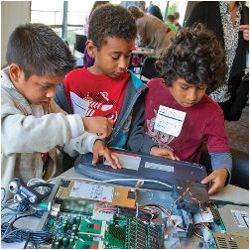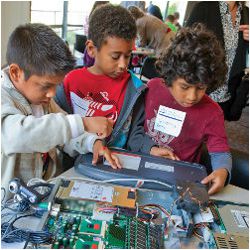
Not long ago, the educational crisis most talked about by computer scientists was the steep decline in the number of undergraduates who picked the field as their major. Today, with those declines in reverse at many U.S. universities, there is a growing recognition—both in the U.S. and internationally—that the real crisis lies not at the college level, but in primary and secondary school.
“The college level is, in a certain sense, too late,” says Stephen Cooper, an associate professor of computer science at Stanford University and chairman of the board of the Computer Science Teachers Association (CSTA), a membership organization that serves U.S. K12 educators. “Though young women decide what they’re majoring in much later than young men, they also decide what they’re not majoring in much earlier than men do. If they decide they’re not interested in computer science at the end of 8th grade, there’s nothing we can do at the college level to change that. We’ve missed the opportunity. But if we change K12, we have a chance to solve this problem.”
Of course, it is not just about recruiting majors or correcting the field’s gender imbalance and lack of minorities. Computer science has become an integral part of nearly all science, technology, engineering, and mathematics (STEM) jobs, and it is of increasing conceptual relevance to a variety of other professions, as well. “There’s really no science that doesn’t involve computation in a pretty fundamental way, and if you look beyond science, what people need to know is what computation can do for them. What are the parts of your job that could be solved computationally? Would you know what kinds of tools to ask for and how to put them together to solve your particular problem?” explains Jan Cuny, a program officer at the National Science Foundation who has headed a number of initiatives to support computer science education.
Yet over the past 20 years, Cuny notes, the percentage of students who take computer science in U.S. high schools has dropped from 25% to 19%. In many schools, the subject is simply not taught; in others, what is covered are soft skills like touch typing and the use of Microsoft Office. Because of the decentralized nature of the U.S. school system, precise student numbers are difficult to discern. However, according to Running on Empty: The Failure to Teach K12 Computer Science in the Digital Age, a 2010 report released by CSTA and ACM, only 14 states have adopted recognized education standards for computer science instruction, and only nine states allow computer science courses to count toward the hours required to graduate for either science or mathematics.
Fitting computer science into the curriculum is a particular problem in the U.S., where each state defines its own academic standards. That is why many educators have focused their attention on the computer science course offered by the Advanced Placement (AP) program, a set of courses that are administered by the College Board, a membership organization that administers standardized tests, and follow a curriculum designed to be equivalent to college-level courses. The current AP computer science course focuses on Java programming and is taught in roughly 2,000 high schools out of 29,000 across the country. Approximately 20,000 students take the end-of-year AP computer science test, as compared to the several hundred thousand who take the AP calculus exam. To increase participation and attract new students to the field, Owen Astrachan of Duke University, Amy Briggs of Middlebury College, CSTA, and others are developing a new AP course that focuses on principles rather than programming. Seizing on a National Research Council directive to rethink the way several AP courses in STEM subjects are taught—urging instructors to emphasize process over knowledge and understanding over facts—the group is developing a pilot program to be released in 2016. The idea, proponents say, is to attract a more diverse student body by concentrating on computational thinking, and to get the course into more schools using the cachet of the AP brand.
“When kids have had no experience with computing, it’s hard to convince them that they want to spend a year learning how to program,” says Cuny, who has helped coordinate NSF’s support for the development of the new course. “What’s more, AP is taught all over the country, and schools like AP because it makes them look academic.”
If young women “decide they’re not interested in computer science at the end of 8th grade,” says Stephen Cooper, “there’s nothing we can do at the college level to change that.”
Managing the way computer science is taught can be a challenge even for countries that do have a standard national curriculum. Israel, for example, has several well-regarded computer science programs at the secondary level, but the subject is considered an elective. According to Tami Lapidot, executive manager of Machshava, the Israeli National Center for Computer Science Teachers, some officials and administrators still fail to understand the importance of the subject. “[They] think that CS and Facebook are the same,” she explains. “In the Ministry of Education, CS is not considered a scientific subject but rather a technology subject.”
England, by contrast, made Information Communications Technology (ICT) compulsory 12 years ago, but left the syllabus quite broad. “It did allow more interesting stuff if the teachers were so minded,” explains Steve Furber, ICL Professor Of Computer Engineering at the University of Manchester and chair of a Royal Society advisory group whose report, Shut Down or Restart? The Way Forward for Computing in UK Schools, was released in January. “But an awful lot of schools identified the lowest common denominator and were teaching ICT through fairly routine Office applications.” Shut Down or Restart points to a nexus of interrelated factors that reinforce the status quo, where ICT is delivered in the form of digital literacy lessons, dismissed by students as uninteresting, and further devalued by schools. Indeed, several recent reports—and the 2011 MacTaggart Lecture by Google executive chairman Eric Schmidt, in which he warned that the U.K.’s IT curriculum “focuses on teaching how to use software, but gives no insight into how it’s made”—have underscored the importance of improving the country’s computer science instruction. Would-be reformers were therefore quite encouraged when Secretary of State for Education Michael Gove announced the “disapplication” of the current ICT curriculum, along with plans to replace it with a more academically rigorous alternative.
Singapore has also seen efforts to rethink its pretertiary computer science curriculum. The republic’s Infocomm Development Authority (IDA) has worked with industry partners and schools to develop courses that are anchored in computational thinking through the CS Reloaded program, which also helps offset course fees. Since March 2011, more than 700 students have been trained under the program in courses that are anchored in computational thinking.
A Lack of Qualified Teachers
Yet even as curricula improve, a larger challenge looms for international computer science education: attracting qualified teachers and keeping them abreast of new developments in a fast-changing field. Many teachers have had no formal training in computer science, coming instead from domains like math, business, and physics. “That isn’t to say we don’t have a lot of great teachers—we do,” explains Jan Cuny. “But students don’t go into the field thinking they’re going to be teachers, and we don’t do a good job of telling them that could be an important thing to do.” In England, only 30% of high school computer science teachers have qualifications that are recognized by the nation’s Department for Education (as opposed to 75%80% in established subjects). In the U.S., only half of the states even have certification programs in the first place.
Encouragingly, a number of initiatives have sprung up to address the problem. In the U.S., the NSF has funded a project called CS10K, which set the goal of training 10,000 computer science teachers across the country. Launched last year, CS10K aims to build a consortium across academia, industry, government agencies, and private foundations, and is part of a larger NSF-sponsored project called Computing Education for the 21st Century, or CE21, which will also fund projects in computing education research and broadening student participation. CSTA, meanwhile, runs a variety of professional development initiatives, including an annual conference and workshops. It also maintains an online repository of research and resources.
“You have maybe one computer science teacher per school,” says CSTA’s Cooper. “At best they have to go to other schools in their district or to other districts to find other teachers who look like them. Offering them the ability to network and build a community is incredibly important.” Israel’s Machshava takes a similar approach, with an annual conference, courses, and summer seminars aimed at fostering professional leadership. In England, a grass-roots group called Computing at School (CAS) has formed a partnership with the British Computer Society to sponsor workshops and coordinate advocacy efforts.
“Everybody’s picked up this sense that change is in the air, and that teachers who want to stay on top of this have got to be proactive,” says Furber. “The good news is CAS membership went up from 300 to 600 or 700” after the publication of Shut Down or Restart. “The bad news is that’s still only one teacher for every 10 secondary schools in the country.”
A variety of university-led programs have begun to appear, as well. Purdue University’s CS4EDU is a joint effort between computer science faculty and the school’s College of Education to create a teaching licensure program that prepares education majors to teach computer science in secondary schools. Carnegie Mellon’s CS4HS reaches out to current high school teachers through workshops aimed to help them teach computer science principles; it has since received funding from Google’s Education Group. Finally, there are regional initiatives like Jane Margolis’s Exploring Computer Science—an NSF-supported program that has helped bring computer science courses to more than 25 schools in the Los Angeles Unified School District—which will also inspire work in other cities.
Managing the way CS is taught can be a challenge even for countries that have a standard national curriculum.
CSTA’s Cooper is optimistic. “We’re making progress. Ten years ago, you couldn’t talk about major school systems in CS, and now there’s work being done in Chicago, Los Angeles, and San Jose. It starts to slowly add up.”
Further Reading
Brandes, O., Vilner, T., and Zur, E.
Software design course for leading CS in-service teachers, Proceedings of the 4th International Conference on Informatics in Secondary Schools, Zurich, Switzerland, Jan. 1316, 2010.
CSTA Teacher Certification Task Force
Ensuring Exemplary Teaching in an Essential Discipline: Addressing the Crisis in Computer Science Teacher Certification, Computer Science Teachers Association, New York, NY, Sept. 2008.
The Royal Society
Shut Down or Restart? The Way Forward for Computing in UK Schools, The Royal Society, London, U.K., Jan. 2012.
Schmidt, E.
“The James MacTaggart Lecture,” MediaGuardian Edinburgh International TV Festival 2011, Edinburgh, Scotland, http://www.edinburghguide.com/video/deregulateandgoglobalgooglechieftellstvfest, August 26, 2011.
Wilson, C., Sudol, L.A., Stephenson, C., and Stehlik, M.
Running on Empty: The Failure to Teach K12 Computer Science in the Digital Age, Association for Computing Machinery, New York, NY, 2010.





Join the Discussion (0)
Become a Member or Sign In to Post a Comment